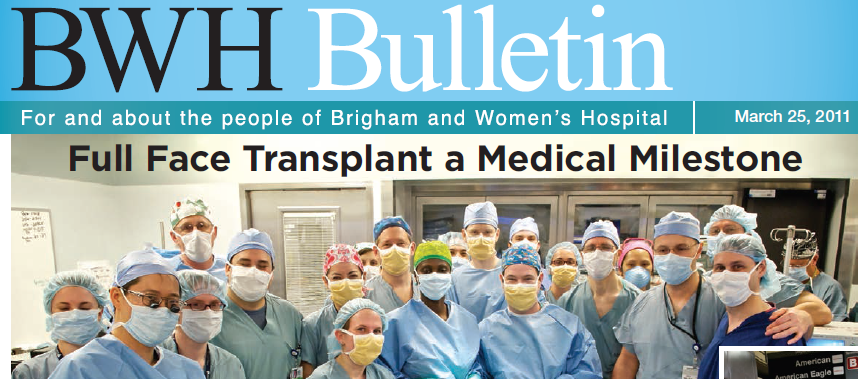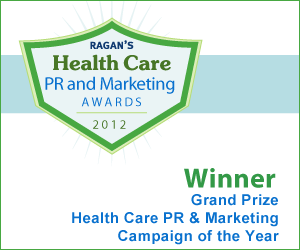Dramatic story about the nation’s first face transplant captivates its audience
Brigham and Women’s Hospital develops a robust social and traditional media campaign around this surgery and nabs the Grand Prize Health Care PR and Marketing Campaign of the Year.

The term “face transplant” has a twinge of science fiction associated with it.
The communications and marketing team at Brigham and Women’s Hospital wanted to take that stigma away.
In March 2011, its 30-member hospital team performed the world’s first face transplant on a 26-year-old patient, Dallas Wiens. The communications team created a strategic, engaging plan to tell Wiens’ story to the world.
For the team’s ability to tell a powerful story (along with monitoring it) and for changing the conversation about face transplants, we award the Grand Prize Health Care PR and Marketing Campaign of the Year.
A face transplant isn’t a life-saving operation; it’s more of a “life-giving” operation, says Dinah Vaprin, director of communications and public affairs.
The hospital showed society what it looked like for a human to look like without a face. It was not only able to accomplish this feat, but shared what it was like for the patient to share his dreams, values and raise his young daughter.
The cost for this campaign was $13,000, which was mostly for a freelance video and photography crew that filmed more than 20 hours. These images were used by the surgical team in presentations at professional government, fundraisers and internal meetings, as well as for multiple local, national, and international media requests, Vaprin says.
Getting organized
A few months before the surgery, the communications team found out that Wiens was listed with the New England Organ Bank for receiving a face transplant. As he would be the nation’s first recipient, the team started developing a plan. Here’s what it included, according to Vaprin:
- Developed a statement to the media from Dallas Wiens that he was placed on the face transplant list.
- Created multimedia materials, including photos and video, to provide to the media to aid in visual storytelling, including photos of Dallas and his family pre- and post-surgery, and photos and video of the surgery.
- Negotiated an exclusive story to The Boston Globe, breaking the news that BWH performed the first full face transplant in the nation. They also held a press conference that was webcasted for media on the day the story broke.
- Negotiated an exclusive interview on “Good Morning America” for the “reveal” of Dallas’ new face.
- Distributed a media advisory to extend media coverage globally. The advisory included a link to a website where information was available for download, including transplant history at BWH, a fact sheet about the procedure, photos and captions, remarks from the press conferences, and a link to the webcast. Media that participated by webcast could submit questions and get answers in real time.
- For its internal audience, the team kept its employees up-to-date on the media coverage on its intranet, as well as via weekly emails. Stories for internal publications were written and video interviews with Dallas were shared.
How can a hospital measure ROI from a story?
Just take a look at these stats to see how the story unfolded, according to Vaprin:
To date, Wiens’ story has been told more than 3,700 times. Following the press conference, more than 1,150 media hits appeared in local and national news media. The story was covered by The Associated Press and Reuters, which combined totaled 683 stories. Additional national coverage included a segment on “ABC World News Tonight” (5 million viewers), Vaprin says.
Following the first press conference, the BWH website hosting transplant information was viewed more than 1,000 times. In addition, 51,000 impressions were made at the BWH Facebook page.
The hospital receives weekly media requests from around the world, especially for Dr. Pomahac to share his perspective in stories and documentaries. In the past 14 months, Dr. Pomahac has been quoted in more than 3,400 media stories.
As a result of the coverage, the division of plastic surgery saw a marked increase in interest about face transplantation. Additionally, the New England Organ Bank saw an increased interest in organ donation.
But the best ROI of all?
At the hospital, another face transplant was performed soon after Dallas’. Then, another one person came forward within the next few months.
Congratulations to the chief staff members responsible for this project: Erin McDonough, Dinah Vaprin, Lori Shanks, Elizabeth Machunski, and Julio Chuy.
To view the BWH Bulletins featuring this story, click here and here.
View More Health Care PR And Marketing Awards 2012 Winners.
Visit Ragan.com/Awards to learn more about awards opportunities.


